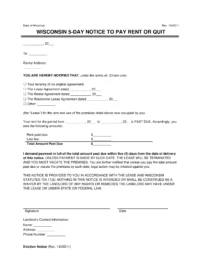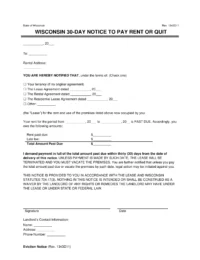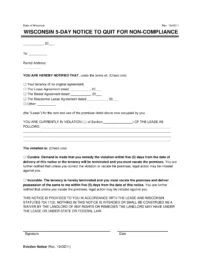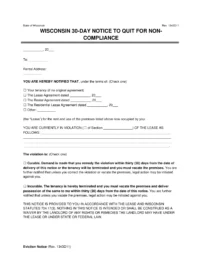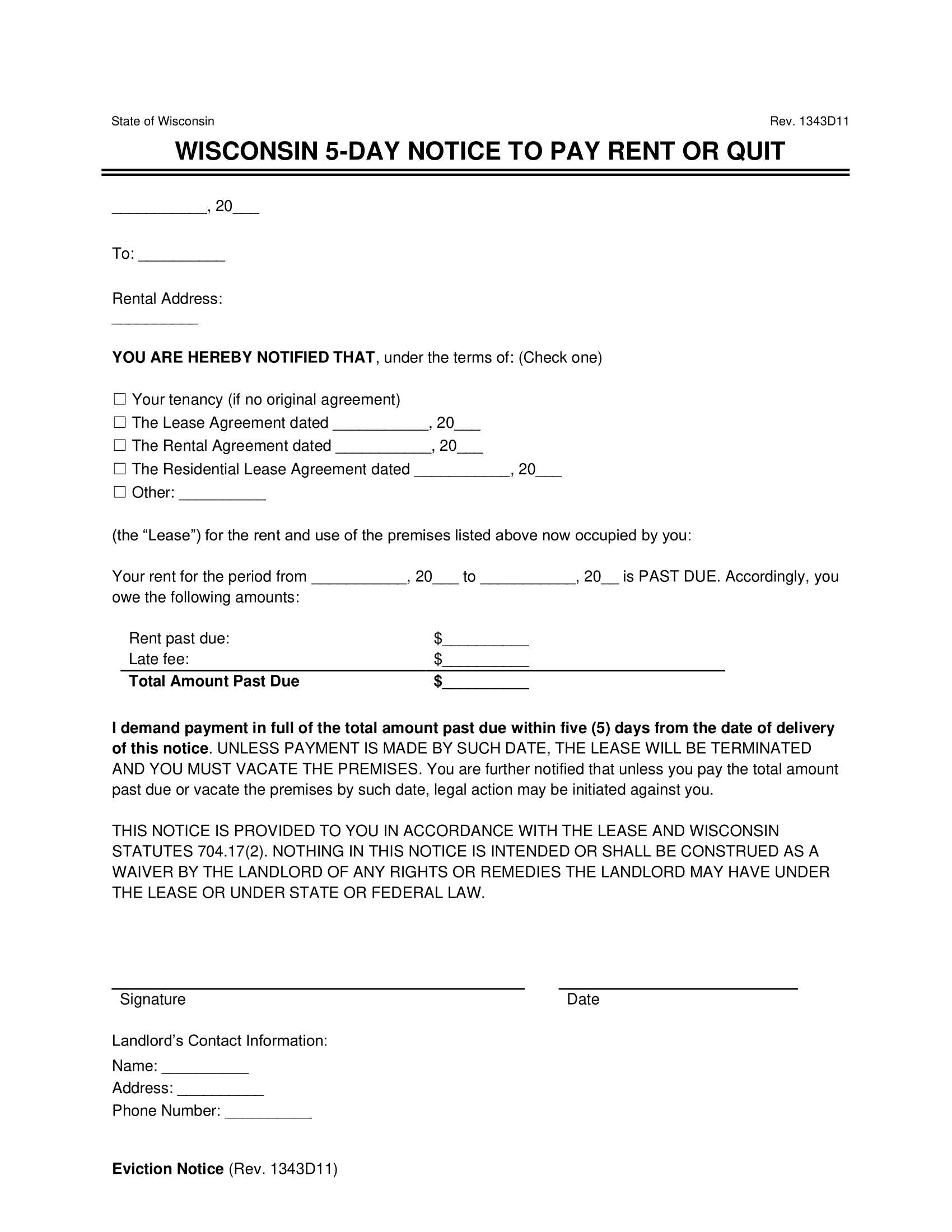A Wisconsin eviction notice is crucial for landlords initiating tenant eviction. This notice conforms to state law, stipulating the grounds for eviction and providing the tenant with the mandated duration to address the matter. The landlord can initiate a lawsuit if the tenant fails to respond within the specified legal timeframe. Completing the eviction requires a court order as mandated by law.
By Type
5-Day Notice to Pay Rent or Quit
Evict a tenant on a lease for a year or less if the tenant hasn’t paid rent on time.
30-Day Notice to Pay Rent or Quit
Evict a tenant on a lease for more than a year if the tenant hasn’t paid rent on time.
5-Day Notice to Quit for Non-Compliance
Give tenants five days’ notice before the eviction process can proceed in court.
30-Day Notice to Quit for Non-Compliance
Give tenants 30 days’ notice before the eviction process can proceed in court. In that time, tenants may be able to fix (or “cure”) the problem.
28-Day Notice Lease Termination
Let a tenant know that you’re ending a month-to-month lease.
Eviction Laws & Requirements
- Eviction Lawsuit: Also called a “Forcible Entry and Detainer” (§ 799.40).
- Rent Grace Period: None unless specified in the lease (ATCP § 134.09(8)).
- Non-Payment of Rent Notice: 5-day notice for the first violation; 14 days for a second violation, if within the same 12-month period (§ 704.17(2)(a) and 704.17(2)(b)).
- Non-Compliance Notice: 5-day notice for the first violation; 14 days for the second violation that falls within 12 months of the first violation (§ 704.17(2)(a) and 704.17(2)(b)).
- Termination (Month-to-Month Lease): 28 days (§ 704.19(3)).
How to Evict a Tenant in Wisconsin
In Wisconsin, eviction lawsuits are governed by Chapter 799 § 799.40 through 799.45 of the Wisconsin Statutes.
Step 1 – Provide Written Notice
A landlord must notify the tenant of the reason(s) for eviction: non-payment of rent, non-compliance, or termination of a month-to-month tenancy. The notice must be properly served with evidence of the service, such as an affidavit or certified mail receipt.
Step 2 – Wait for the Tenant’s Response
The tenant has five days to fix the problem, either by payment or curing non-compliance; if they do so, the landlord may not proceed with the eviction filing. For a second violation within the same year, the tenant must be given 14 days’ notice to vacate the premises, but the landlord doesn’t need to allow the tenant to pay.
If the tenant has been living on the property for more than one year, they must have 30 days to pay rent or fix a compliance issue.
Step 3 – File for Eviction
If the tenant fails to respond by the required time and remains on the property, the landlord files a Forcible Entry and Detainer (eviction) action in the local circuit court where the property is located.
Landlords must file a Summons and Complaint and state why they want the tenant to move out in the eviction complaint. Landlords must also complete a Non-Military Service Affidavit and Affidavit of Service of Notice. The court will set a date for the hearing and return on that date to plead your case to the judge.
Step 4 – Serve the Tenant
The court will keep the original summons and complaint, and you must deliver the copies to a process server to serve your tenant. The tenant must be served five (5) days before the court date and may defend themselves by filing an Answer and Counterclaim form.
Step 5 – Attend the Court Hearing
Attend the court hearing, during which you and the tenant will present your evidence for the case. The court will weigh both sides and make a fair, informed decision.
Step 6 – Receive the Writ of Restitution
If the court finds for the landlord, it will grant a Writ of Restitution. The landlord must provide this form to the sheriff, who will complete the eviction. The sheriff will have ten (10) days to evict the tenant after receiving the Writ of Restitution.
Related Wisconsin Court Forms
- Summons and Complaint (SC-500I): The landlord completes this form and files it with the local circuit court.
- Declaration of Non-Military Service (GF-175): The landlord files this form along with the eviction complaint to state whether a tenant is on active military duty.
- Affidavit of Service (SC-5100V): This form affirms the proper service of the Summons and Complaint on a tenant.
- Answer and Counterclaim (SC-5200V): Tenants may respond to the allegations in the eviction complaint by filing this document with the court. A copy must also be delivered to the landlord.
- Writ of Restitution (SC-512): This document is issued by the court after an eviction lawsuit has been settled in favor of the landlord, and it allows the sheriff to remove the tenant from the premises.
